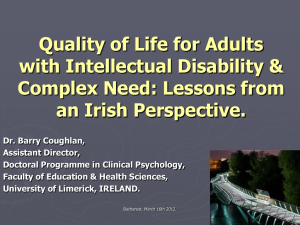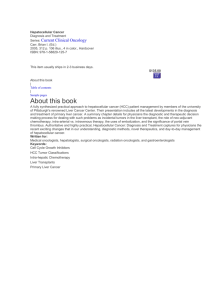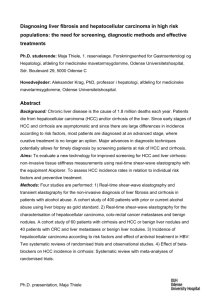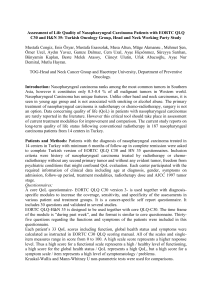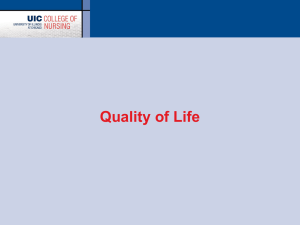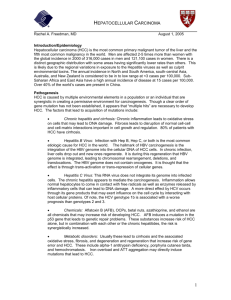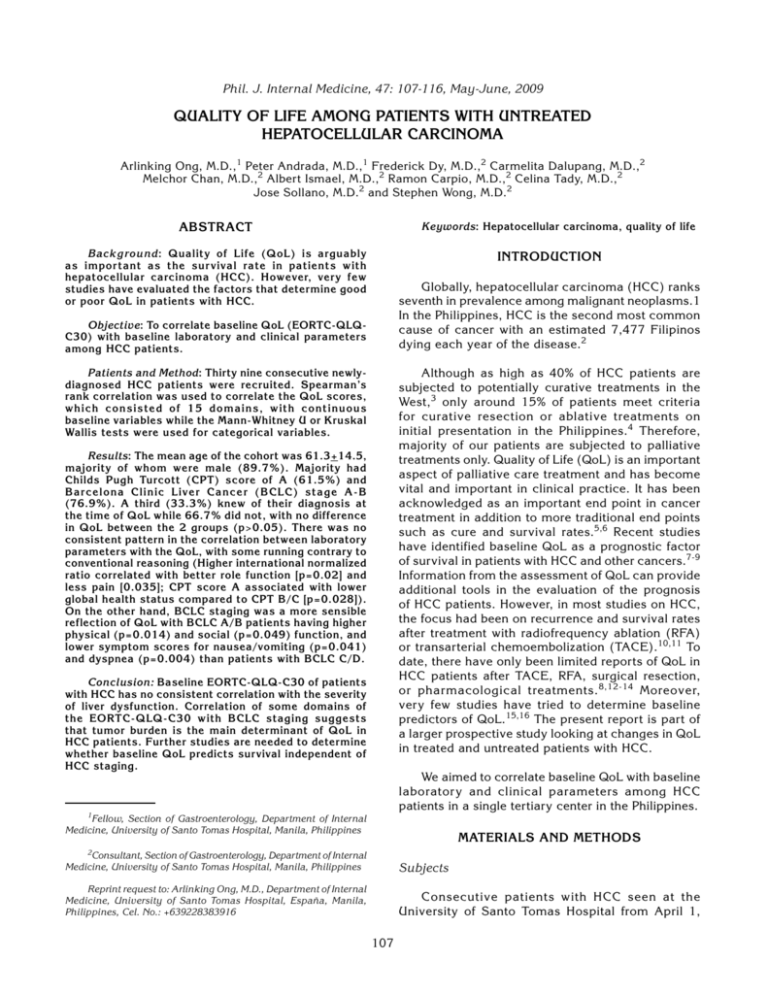
Original Articles
Quality of Life Among Patients with Untreated Hepatocellular Carcinoma 107
Phil. J. Internal Medicine,
47: 107-116, May-June, 2009
QUALITY OF LIFE AMONG PATIENTS WITH UNTREATED
HEPATOCELLULAR CARCINOMA
Arlinking Ong, M.D.,1 Peter Andrada, M.D.,1 Frederick Dy, M.D., 2 Carmelita Dalupang, M.D.,2
Melchor Chan, M.D.,2 Albert Ismael, M.D.,2 Ramon Carpio, M.D.,2 Celina Tady, M.D.,2
Jose Sollano, M.D.2 and Stephen Wong, M.D.2
ABSTRACT
Keywords: Hepatocellular carcinoma, quality of life
Background: Quality of Life (QoL) is arguably
as impor tant as the sur vival rate in patients with
hepatocellular carcinoma (HCC). However, very few
studies have evaluated the factors that determine good
or poor QoL in patients with HCC.
INTRODUCTION
Globally, hepatocellular carcinoma (HCC) ranks
seventh in prevalence among malignant neoplasms.1
In the Philippines, HCC is the second most common
cause of cancer with an estimated 7,477 Filipinos
dying each year of the disease.2
Objective: To correlate baseline QoL (EORTC-QLQC30) with baseline laboratory and clinical parameters
among HCC patients.
Although as high as 40% of HCC patients are
subjected to potentially curative treatments in the
West, 3 only around 15% of patients meet criteria
for curative resection or ablative treatments on
initial presentation in the Philippines. 4 Therefore,
majority of our patients are subjected to palliative
treatments only. Quality of Life (QoL) is an important
aspect of palliative care treatment and has become
vital and important in clinical practice. It has been
acknowledged as an important end point in cancer
treatment in addition to more traditional end points
such as cure and survival rates. 5,6 Recent studies
have identified baseline QoL as a prognostic factor
of survival in patients with HCC and other cancers.7-9
Information from the assessment of QoL can provide
additional tools in the evaluation of the prognosis
of HCC patients. However, in most studies on HCC,
the focus had been on recurrence and survival rates
after treatment with radiofrequency ablation (RFA)
or transarterial chemoembolization (TACE).10,11 To
date, there have only been limited reports of QoL in
HCC patients after TACE, RFA, surgical resection,
or pharmacological treatments. 8,12-14 Moreover,
very few studies have tried to determine baseline
predictors of QoL. 15,16 The present report is part of
a larger prospective study looking at changes in QoL
in treated and untreated patients with HCC.
Patients and Method: Thirty nine consecutive newlydiagnosed HCC patients were recruited. SpearmanÊs
rank correlation was used to correlate the QoL scores,
which consisted of 15 domains, with continuous
baseline variables while the Mann-Whitney U or Kruskal
Wallis tests were used for categorical variables.
Results: The mean age of the cohort was 61.3+14.5,
majority of whom were male (89.7%). Majority had
Childs Pugh Turcott (CPT) score of A (61.5%) and
B a rcel ona Cl i n i c Liver C a ncer (BC LC ) st age A -B
(76.9%). A third (33.3%) knew of their diagnosis at
the time of QoL while 66.7% did not, with no difference
in QoL between the 2 groups (p>0.05). There was no
consistent pattern in the correlation between laboratory
parameters with the QoL, with some running contrary to
conventional reasoning (Higher international normalized
ratio correlated with better role function [p=0.02] and
less pain [0.035]; CPT score A associated with lower
global health status compared to CPT B/C [p=0.028]).
On the other hand, BCLC staging was a more sensible
reflection of QoL with BCLC A/B patients having higher
physical (p=0.014) and social (p=0.049) function, and
lower symptom scores for nausea/vomiting (p=0.041)
and dyspnea (p=0.004) than patients with BCLC C/D.
Conclusion: Baseline EORTC-QLQ-C30 of patients
with HCC has no consistent correlation with the severity
of liver dysfunction. Correlation of some domains of
the EORTC-QLQ-C30 with BCLC staging suggests
that tumor burden is the main determinant of QoL in
HCC patients. Further studies are needed to determine
whether baseline QoL predicts survival independent of
HCC staging.
We aimed to correlate baseline QoL with baseline
laborator y and clinical parameters among HCC
patients in a single tertiary center in the Philippines.
1
Fellow, Section of Gastroenterology, Department of Internal
Medicine, University of Santo Tomas Hospital, Manila, Philippines
MATERIALS AND METHODS
2
Consultant, Section of Gastroenterology, Department of Internal
Medicine, University of Santo Tomas Hospital, Manila, Philippines
Subjects
Reprint request to: Arlinking Ong, M.D., Department of Internal
Medicine, University of Santo Tomas Hospital, España, Manila,
Philippines, Cel. No.: +639228383916
Consecutive patients with HCC seen at the
University of Santo Tomas Hospital from April 1,
107
108 Ong A, et al.
2008 to October 31, 2008 were recruited for the study.
HCC was diagnosed based on the algorithm proposed
by the American Association for the Study of Liver
Diseases.17 Briefly, tumors that were >2 cm in diameter
were diagnosed as HCC if the dynamic imaging study
was typical of HCC with a serum alpha-fetoprotein
(AFP) >200 ng/mL, or a liver biopsy revealed HCC.
For tumors <2 cm in diameter, 2 dynamic imaging
studies that were typical of HCC or a liver biopsy
should reveal HCC were used to diagnose HCC.
Patients with newly diagnosed HCC who have never
undergone any form of HCC treatment in the past, and
are able to complete the questionnaire were included
into the study. Patients who have undergone systemic
chemotherapy or took other medications that may
modify QoL within 3 months of study enrolment were
excluded from the study.
Quality of Life Assessment Tool
The validated Tagalog or English versions,
depending on the language preference of the patient,
of the European Organization for Research and
Treatment of Cancer Study Group on Quality of Life
(EORTC QLQ-30) was used.18 (Appendix A and B)
The EORTC QLQ-30 is a validated questionnaire
widely used in clinical trials on varied cancer
patients. It incorporates a range of QoL issues that
is relevant to a broad range of cancer patients. It
has five functional scales (physical, role, cognitive,
emotional and social), three symptom scales (fatigue,
pain and nausea/vomiting), a global QoL scale, and
six single items (dyspnea, insomnia, appetite loss,
constipation, diarrhea and financial difficulties). 18
It has been translated to different languages and
validated for many cancer types, including patients
with HCC.19 All scales and items of the EORTC QLQC30 range in score from 0 to 100. A high score for a
functional or global QoL scale represents a relatively
high/healthy level of functioning or global QoL, and
a high score for a symptom scale or item represents
more severe symptoms or problems. 20
Baseline Assessment
Quality of life, and laboratory, clinical and tumor
parameters were determined and recorded at the
baseline visit. PatientÊs knowledge or ignorance of
the presence of HCC was noted and analyzed due to
the unavoidable fact that some patients were already
cognizant of their diagnosis (e.g. referred from another
institution) at the time of administration of the QoL
questionnaire. Laboratory examinations included
were complete blood count (CBC), prothrombin time
(PT), and serum alanine aminotransferase (ALT),
aspartate aminotransferase (AST), albumin, total
bilirubin and alpha-fetoprotein (AFP) levels. Markers
of chronic viral hepatitis (hepatitis B surface antigen
[HBsAg] and antibody to hepatitis C [anti-HCV]) and
alcoholic intake were likewise determined.
The etiology of liver disease and the presence
or absence of hepatic decompensation (jaundice,
encephalopathy or ascites), as well as the tumor
characteristics (size and number of nodules, presence
or absence of intrahepatic vessel involvement or
extrahepatic metastasis) at baseline were recorded.
Staging of HCC was done according to Barcelona
Clinic Liver Cancer (BCLC) criteria.
Statistical Analysis
The EORTC QLQ-C30 scores of all 5 functioning
domains, the global quality of life domain and the
3 symptom domains plus 6 single items related to
symptoms were included in the prognostic analysis
as continuous variables. The scores were transformed
into a scale range from 0 to 100. SpearmanÊs rank
correlation was used to correlate the QoL scores with
continuous baseline variables while the Mann-Whitney
U or Kruskal Wallis tests were used for categorical
variables. A p-value of <0.05 was considered as
statistically significant. All analysis was performed
using SPSS v.16 statistical analysis software (SPSS,
Chicago, IL)
RESULTS
Thirty nine patients were recruited for the study,
with a mean age of 61.3 + 14.5 and majority of
which were composed of male patients (89.7%).
Only 4 (10.2%) patients were asymptomatic with the
majority of those who were symptomatic complaining
of abdominal pain (74.3%). Other symptoms included
abdominal enlargement (2.6%), anorexia (7.7%),
jaundice (2.6%) and weight loss (2.6%). More than
half (56.4%) of the patients had AFP values of <400
ng/mL. Twenty two (56.4%) patientsÊ HCC was due to
hepatitis B while other causes were alcohol (15.4%),
cryptogenic (15.4%) or hepatitis C (2.6%). The mean
tumor size was 8.82 + 4.69 with most of the patient
having a CPT score of A (61.5%), followed by 14
(35.9%) having a score of B and 1 (2.6%) having a
score of C. BCLC staging of the patients were mostly
of stage B (74.4%) and stage C (17.9%). (Table I)
Table II shows the comparison of QoL scores
among those who were aware (n=13) and unaware
(n=26) of their diagnosis at the time of baseline QoL
assessment. The scores between the 2 groups did
Quality of Life Among Patients with Untreated Hepatocellular Carcinoma 109
not show any statistical difference except for higher
scores for cognitive function in patients who were
aware of their diagnosis. (p= 0.031) There was no
difference (p>0.05) in baseline laboratory and clinical
parameters between the two groups. (Table I)
Expectedly, patients who were asymptomatic
tended to have better role (p=0.034) and emotional
function (p=0.021), with lower pain (p=0.004) and
fatigue scores (p=0.013) compared to patients who
had symptoms on initial presentation. Patients with
lower platelets tended to have higher social function
(p=0.022) and less nausea/ vomiting (p=0.029), INR
levels were positively correlated with role function
(p=0.020) but inversely correlated with pain scores
(p=0.035), AST levels were inversely correlated
with role function (p=0.042) and constipation scores
(p=0.038), and ALT levels were directly correlated
with nausea/vomiting scores (p=0.017). Patients with
BCLC stages A and B had better physical (p=0.014)
and social (p=0.049) function, and lower symptom
scores for nausea/vomiting (p=0.041) and dyspnea
(p=0.004) than patients with BCLC stages C and D.
Furthermore, patients with lower performance status
(PST) scores (PST 0-1) had better physical function
(p=0.008) and less dyspnea (p=0.0027) compared
to patients with higher scores (PST 2-4). (Table III)
Table I. Baseline Characteristics of HCC Patients Aware and Unaware of Their Diagnosis
Characteristics
Age
Sex
Male
Female
Chief Complaint
Asymptomatic
Abdominal Enlargement
Abdominal Pain
Anorexia
Jaundice
Weight Loss
Hemoglobin
Hematocrit
Platelet
Protime (INR)
AST (IU/L)
ALT (IU/L)
Bilirubin (mg/dL)
Albumin (mg/dL)
AFP (log10)
<200 (ng/mL)
>200 (ng/mL)
Etiology
Hepatitis B
Alcohol
Cryptogenic
Hepatitis B +
Hepatitis C
Tumor size
CPT score
A
B
C
BCLC Staging
A
B
C
D
PST
0-1
2-4
Unaware of diagnosis
n=26
Aware of diagnosis
n=13
p-value
All patients
n = 39
62 + 16.63
59.92 + 9.19
0.679
0.709
61.3 + 14.5
23 (59%)
3 (7.7%)
12 (30.7%)
1 (2.6%)
2 (5.1%)
1 (2.6%)
21 (53.8%)
1 (2.6%)
1 (2.6%)
0
118.87 + 19.36
35.53 + 5.99
298.05 + 180.04
1.22 + 0.35
91.03 + 55.55
62.54 + 45.33
1.69 + 1.75
3.44 + 0.54
2.34 + 1.1
12 (30.8%)
14 (35.9%)
2 (5.1%)
0
8 (20.5%)
2 (5.1%)
0
1 (2.6%)
126.75 + 23.47
37.38 + 7.73
310.73 + 209.57
1.19 + 0.23
174.25 + 164.7
126.14 + 117.58
1.75 + 2.06
3.65 + 0.75
2.45 + 1.1
5 (12.8%)
8 (20.5%)
16 (41%)
4 (10.2%)
5 (12.8%)
1 (2.6%)
10 (25.6%)
2 (5.1%)
1 (2.6%)
0
9.65 + 4.93
7.24 + 3.88
15 (38.5%)
10 (25.6%)
1 (2.6%)
9 (23.1%)
4 (10.2%)
0
0
19 (48.7%)
5 (12.8%)
2 (5.1%)
1 (2.6%)
10 (25.6%)
2 (5.1%)
0
22 (56.4%)
4 (10.2%)
12 (30.8%)
1 (2.6%)
35 (89.7%)
4 (10.3%)
0.366
0.397
0.532
0.862
0.828
0.135
0.118
0.939
0.329
0.777
0.819
4 (10.2%)
1 (2.6%)
29 (74.3%)
3 (7.7%)
1 (2.6%)
1 (2.6%)
121.61 + 20.7
36.17 + 6.53
302.70 + 187.89
1.21 + 0.30
126.1 + 118.5
89.32 + 87.0
1.72 + 1.86
3.51 + 0.61
2.38 + 1.10
17 (43.6 %)
22 (56.4%)
0.765
26 (66.67%)
6 (15.4%)
6 (15.4%)
1 (2.6%)
0.135
0.660
8.82 + 4.69
24 (61.5%)
14 (35.9%)
1(2.6%)
0.378
1 (2.6%)
29 (74.4%)
7 (17.9%)
2 (5.1%)
0.498
34 (87.2%)
5 (12.8%)
HCC ă hepatocellular carcinoma, AST ă aspartate aminotransferace, ALT ă alanine aminotransferace, AFP ă alpha fetoprotein, CPT ă ChildPugh Turcott, BCLC ă Barcelona Clinic Liver Cancer, PST- Performance status score
110 Ong A, et al.
Table II. Comparison of QOL Scores Between Patients Who Were Aware and Unaware of Their Diagnosis
Unaware of diagnosis
n=26
Aware of diagnosis
n=13
p-value
Global function
61.86 + 23.9
51.28 + 23.5
0.099
Physical function
71.03 + 23.3
77.44 + 26.7
0.212
Role function
60.25 + 33.0
65.38 + 29.2
0.649
Emotional function
55.77 + 27.6
67.95 + 20.9
0.142
Cognitive function
71.15 + 27.7
89.74 + 12.8
0.031
Social function
47.44 + 39.1
62.82 + 32.0
0.249
Fatigue
47.86 + 29.3
48.70 + 33.8
0.988
Nausea / vomiting
9.61 + 20.1
7.69 + 12.93
0.785
Pain
51.9 + 34.7
48.72 + 30.7
0.705
Dyspnea
20.5 + 31.3
20.51 + 21.7
0.601
Insomnia
32.05 + 37.1
33.33 + 38.5
0.937
Appetite loss
28.20 + 33.6
43.59 + 45.9
0.354
Constipation
20.50 + 34.1
15.38 + 32.2
0.522
Diarrhea
15.38 + 31.6
23.07 + 39.4
0.559
Financial
80.76 + 32.0
76.92 + 34.4
0.669
Table III. Correlation Between Baseline Clinical and Laboratory Characteristics and QoL Scores*
Asymptomatic
VS
Symptomatic
Hgb
platelet
INR
AST
ALT
CPT
BCLC
PST
Global health status
NS
-0.510
(0.013)
NS
NS
NS
NS
0.028
NS
NS
Physical function
NS
NS
NS
NS
NS
NS
NS
0.014
0.008
Role function
0.034
NS
NS
0.391
(0.020)
-0.470
(0.042)
NS
NS
NS
NS
Emotional function
0.021
NS
NS
NS
NS
NS
NS
NS
NS
NS
NS
-0.416
(0.022)
NS
NS
NS
NS
0.049
NS
0.013
NS
NS
NS
NS
NS
NS
NS
NS
NS
NS
0.398
(0.029)
NS
NS
0.539
(0.017)
NS
0.041
NS
0.004
NS
NS
-0.357
(0.035)
NS
NS
NS
NS
NS
Dyspnea
NS
NS
NS
NS
NS
NS
NS
0.004
0.027
Constipation
NS
NS
NS
NS
-0.479
(0.038)
NS
NS
NS
NS
Social function
Fatigue
Nausea / vomiting
Pain
NS = not significant
*Numbers represent R value (p-values)
Quality of Life Among Patients with Untreated Hepatocellular Carcinoma 111
DISCUSSION
Hepatocellular carcinoma is one of the common
neoplasms worldwide and the effect of treatment
modalities on the natural history of the disease should
be determined not only from the observed tumor
response and impact on survival, but on the effect of
treatment on quality of life as well. Both the disease
and the treatment itself can be severely debilitating
and the need to consider the impact on health-related
QoL in making patient management or treatment
decisions is now well accepted. 21 The EORTC
QLQ- C30 QoL questionnaire is multidimensional
and covers various aspects of a patientÊs life, which
makes it possible to explore which QoL dimension
would correlate with the severity of the patientÊs
disease.
Unlike a previous study 15 showing older age
group having poorer QoL or females having a
poorer QoL, our study did not show any statistically
significant relationships between age, sex and the
different domains of the QoL and is similar to the
findings by Yeo et al9 where they showed that age and
gender was not a predictive factor of QoL. Baseline
characteristics such as age, sex, liver function test
and CPT score from different studies 9,15 were almost
the same when compared to our study. However, only
the Hong Kong study9 was similar to our study with
regards to the etiology of the underlying liver disease
being predominantly due to Hepatitis B rather than
due to Hepatitis C. Furthermore, the study by Yeo
et al9 used EORTC QLQ-C30 as the QoL instrument
which may explain the similar findings while SF 3615
was used in the other study which may explain the
difference with our results.
There was no consistent pattern in the correlation
between laboratory parameters with the QoL. This was
an interesting finding with no deducible explanation
for some such as the finding that higher international
normalized ratio correlated with better role function
and less pain, and that CPT A was associated with
lower global health status compared to CPT B/C. On
the other hand, BCLC staging was a more sensible
reflection of QoL with BCLC A/B patients having
higher physical and social function, and lower
symptom scores for nausea/vomiting and dyspnea
than patients with BCLC C/D. This suggests that
tumor burden is the main determinant of QoL among
Filipino HCC patients. Aside from using a different
QoL questionnaire, most of the studies compared
the baseline characteristics and CPT scores with the
different domains of the QoL.9,15 The study by Kondo
et al15 showed that lower albumin and higher bilirubin
were strong predictors of impaired QoL. Correlation
of the liver function was present in their study and
not ours probably because their study compared
patients with and without HCC and not purely those
with HCC. In the study by Yeo et al9, both tumor stage
according to the Okuda system and certain domains
of the EORTC QLQ-C30 (role functioning, physical
functioning and appetite loss) were independent
predictors of survival in HCC patients. However, no
correlation between QoL scores and Okuda staging
was done. The BCLC staging system may be a
better predictor of survival compared to other staging
systems in patients with HCC.22 This may be because
the BCLC system includes the patientÊs functional
status, which might be a driving force for the QoL
changes in our study. This is confirmed by the fact
there was also a significant correlation between the
patientÊs PST scores with the QoL domains.
Among patients with hepatocellular carcinoma
with majority of patients suffering from co-existing
cirrhosis, the usefulness of a QoL instrument based on
EORTC QLQ-C30 in assessing patients with HCC could
be further enhanced by the addition of assessments
related to disease specific module in the recently
reported EORTC QLQ HCC-18 questionnaire.23
Symptoms from chronic liver disease have been
taken into consideration in the latter and includes that
of abdominal distension from ascites, limb edema
related to sodium and fluid retention, pruritus related
to hyperbilirubinemia, bleeding related to clotting
impairment and thrombocytopenia.23 The inclusion
of a HCC specific questionnaire into the present study
could potentially improve the sensitivity of baseline
QoL as a prognosticator in these patients. However,
the said questionnaire has not been prospectively
validated yet and so was not used.
Potential limitations of the current study may
include the relatively small sample size and no follow
up. Future larger scale studies using similar QoL
tool evaluated at multiple time points with follow
up is warranted. Also further studies are needed to
determine whether baseline QoL predicts survival
independent of HCC staging.
CONCLUSION
Baseline EORTC-QLQ-C30 of patients with HCC
has no consistent correlation with the severity of
liver dysfunction. Correlation of some domains of the
EORTC-QLQ-C30 with BCLC staging suggests that
tumor burden is the main determinant of QoL in HCC
patients.
REFERENCE
1. Beasley RP, Huang EL: Overview on the Epidemiology
of Hepatocellular Carcinoma. Viral Hepatitis and Liver
Disease. Edited by Hollinger FB, Lemon SM, Margolis S.
Batimore, Williams and Wilkins, 1991:532.
112 Ong A, et al.
2. Philippine Facts and Figures: Estimaed Cancer Deaths
in 2005 by Site and Sex. www.cnetwork.org.ph . Date
accessed: December 31, 2008.
3. Bruix J, Llovet JM: Prognostic Prediction and Treatment
Strategy in Hepatocellular Carcinoma. Hepatology;
35:519, 2002.
4. Andrada P, Wong S, Sollano J, Dy F, Dalupang C, Chan M,
Ismael A, Carpio R: Filipino Patients with Hepatocellular
Carcinoma Have Poor Survival According to Barcelona
Clinic Liver Cancer Criteria. The 4th APASL Single Topic
Conference on Viral Related HCC and Working Committee
Meeting APASL CONSENSUS on HCC. Bali, Indonesia,
2008:31.
5. Editorial. Quality of Life and Clinical Trials. Lancet; 346:1,
1995.
6. Moinpour CM: Measuring Quality of Life: An Emerging
Science. Semin Oncol 1994;21:48-60; Discussion 60-3.
7. Dancey J, Zee B, Osoba D, Whitehead M, Lu F, Kaizer L,
Latreille J, Pater JL: Quality of Life Scores: An Independent
Prognostic Variable in A General Population of Cancer
Patients Receiving Chemotherapy. The National Cancer
Institute of Canada Clinical Trials Group. Qual Life Res;
6:151, 1997.
8. Wang YB, Chen MH, Yan K, Yang W, Dai Y, Yin SS:
Quality of Life After Radiofrequency Ablation Combined
with Transcatheter Ar terial Chemoembolization for
Hepatocellular Carcinoma: Comparison with Transcatheter
Arterial Chemoembolization Alone. Qual Life Res; 16:389,
2007.
14. Zhao JB, Li YH, Chen Y, al. E: Evaluation of Quality of
Life Before and After Interventional Therapy in Patients
with Primary Hepatocellular Carcinoma. Chin J Radiol;
36:873, 2002.
15. Kondo Y, Yoshida H, Tateishi R, Shiina S, Mine N, Yamashiki
N, Sato S, Kato N, Kanai F, Yanase M, Akamatsu M,
Teratani T, Kawabe T, Omata M: Health-Related Quality
of Life of Chronic Liver Disease Patients With and Without
Hepatocellular Carcinoma. J Gastroenterol Hepatol;
22:197, 2007.
16. Steel JL, Chopra K, Olek MC, Carr BI: Health-Related
Quality of Life: Hepatocellular Carcinoma, Chronic Liver
Disease, and the General Population. Qual Life Res;
16:203, 2007.
17. Bruix J, Sherman M: Management of Hepatocellular
Carcinoma. Hepatology; 42:1208, 2005.
18. Aaronson NK, Ahmedzai S, Bergman B, Bullinger M, Cull
A, Duez NJ, Filiberti A, Flechtner H, Fleishman SB, de
Haes JC, et al.: The European Organization for Research
and Treatment of Cancer QLQ-C30: A Quality-of-Life
Instrument for Use in International Clinical Trials in
Oncology. J Natl Cancer Inst; 85:365, 1993.
19. Aaronson NK, Ahmedzai S, Bergman B, Bullinger M, Cull
A, Duez NJ, Filiberti A, Flechtner H, Fleishman SB, de
Haes JCJM, Kaasa S, Klee MC, Osoba D, Razavi D, Rofe
PB, Schraub S, Sneeuw KCA, Sullivan M, Takeda F: The
European Organisation for Research and Treatment of
Cancer QLQ-C30: A Quality-of-Life Instrument for Use
in International Clinical Trials in Oncology. Journal of the
National Cancer Institute; 85:365, 1993.
9. Yeo W, Mo FK, Koh J, Chan AT, Leung T, Hui P, Chan L, Tang
A, Lee JJ, Mok TS, Lai PB, Johnson PJ, Zee B: Quality of
Life is Predictive of Survival in Patients with Unresectable
Hepatocellular Carcinoma. Ann Oncol; 17:1083, 2006.
20. Fayers PM, Aaronson NK, Bjordal K, al. E: EORTC QL-C30
Scoring Manual. 2nd ed. Belgium: EORTC Data Center,
1999.
10. Buscarini L, Buscarini E, Di Stasi M, Vallisa D, Quaretti P,
Rocca A: Percutaneous Radiofrequency Ablation of Small
Hepatocellular Carcinoma: Long-Term Results. Eur Radiol;
11:914, 2001.
21. Fayers P, Bottomley A: Quality of Life Research Within the
EORTC-the EORTC QLQ-C30. European Organisation for
Research and Treatment of Cancer. Eur J Cancer 2002;38
Suppl 4:S125-33.
11. Ramsey DE, Kernagis LY, Soulen MC, Geschwind JF:
Chemoembolization of Hepatocellular Carcinoma. J Vasc
Interv Radiol; 13:S211, 2002.
22. Grieco A, Pompili M, Caminiti G, Miele L, Covino M, Alfei
B, Rapaccini GL, Gasbarrini G: Prognostic Factors for
Survival in Patients with Early-Intermediate Hepatocellular
Carcinoma Undergoing Non-Surgical Therapy: Comparison
of Okuda, CLIP, and BCLC Staging Systems in A Single
Italian Centre. Gut; 54:411, 2005.
12. Chow PK, Tai BC, Tan CK, Machin D, Win KM, Johnson
PJ, Soo KC: High-Dose Tamoxifen in the Treatment of
Inoperable Hepatocellular Carcinoma: A Multicenter
Randomized Controlled Trial. Hepatolog; 36:1221, 2002.
13. Poon RT, Fan ST, Yu WC, Lam BK, Chan FY, Wong J: A
Prospective Longitudinal Study of Quality of Life After
Resection of Hepatocellular Carcinoma. Arch Surg;
136:693, 2001.
23. Blazeby JM, Currie E, Zee BC, Chie WC, Poon RT,
Garden OJ: Development of A Questionnaire Module to
Supplement the EORTC QLQ-C30 To Assess Quality of
Life in Patients with Hepatocellular Carcinoma, the EORTC
QLQ-HCC18. Eur J Cancer; 40:2439, 2004.
Quality of Life Among Patients with Untreated Hepatocellular Carcinoma 113
APPENDIX A
ENGLISH VERSION OF THE EORTC QLC-C30 QUESTIONNAIRE
EORTC QLC-C30 (version 3)
We are interested in some things about you and your health. Please answer all of the questions yourself by
circling the number that best applies to you. There are no “right” or “wrong” answers. The information that
you provide will remain strictly confidential.
Please fill in your initials:
Your birthdate (Day, Month, Year)
Today’s date (Day, Month, Year)
1.
2.
3.
4.
5.
Do you have any trouble doing strenuous activities,
like carrying a heavy shopping bag or a suitcase?
Do you have any trouble taking a long walk?
Do you have any trouble taking a short walk outside
of the house?
Do you need to stay in bed or a chair during the day?
Do you need help with eating, dressing, walking
yourself or using the toilet?
Not at
All
A
Little
Quite
a Bit
Very
Much
1
1
2
2
3
3
4
4
1
1
2
2
3
3
4
4
1
2
3
4
Not at
All
A
Little
Quite
a Bit
Very
Much
1
2
3
4
1
1
1
1
1
1
1
1
1
1
2
2
2
2
2
2
2
2
2
2
3
3
3
3
3
3
3
3
3
3
4
4
4
4
4
4
4
4
4
4
During the past week:
6.
7.
8.
9.
10.
11.
12.
13.
14.
15.
16.
Were you limited in doing either your work
or other daily activities?
Were you limited in pursuing your hobbies
or other leisure time activities
Were you short of breath?
Have you had pain?
Did you need to rest?
Have you had trouble sleeping?
Have you felt weak?
Have you lacked appetite?
Have you felt nauseated?
have you vomited?
Have you been constipated?
Please go on to the next page
114 Ong A, et al.
During the past week:
17.
18.
19.
20.
Not at
All
A
Little
Quite
a Bit
Very
Much
Have you had diarrhea?
Were you tired?
Did pain interfere with your daily activities?
Have you had difficulty in concentrating on things,
like reading a newspaper or watching television?
1
1
1
2
2
2
3
3
3
4
4
4
1
2
3
4
21.
Did you feel tense?
1
2
3
4
22.
Did you worry?
1
2
3
4
23.
Did you feel irritable?
1
2
3
4
24.
Did you feel depressed?
1
2
3
4
25.
26.
Have you had difficulty remembering things?
Has your physical condition or medical treatment
interfaced with your family life?
1
2
3
4
1
2
3
4
Has your physicial condition or medical treatment
interfaced with your social activities?
1
2
3
4
Has your physical condition or medical treatment
caused you financial difficulties?
1
2
3
4
27.
28.
For the following questions please circle the number between 1 and 7 that best applies to you
29.
How would you rate your overall health during the past week?
1
2
3
4
5
6
Very poor
30.
7
Excellent
How would you rate your overall quality of life during the past week?
1
Very poor
2
3
4
5
6
7
Excellent
© Copyright 1995 DCRTC Quality of Life Group. All rights reserved. Version 3
Quality of Life Among Patients with Untreated Hepatocellular Carcinoma 115
APPENDIX B
TAGALOG VERSION OF THE EORTC QLC-C30 QUESTIONNAIRE
EORTC QLC-C30 (version 3)
Kami ay interesado sa iilang bagay tungkol sa iyo at iyong kalusugan. pakisagot lamang po ang mga tanong
sa pamamagitan na pagbilog sa bilang na tumutukoy sa iyo. Walang “tama” o “maling” sagot sa tanong. Ang
impormasyon na iyong ibinigay ay mananatiling lihim.
Pakisulat ang iyong pangalan:
Iyong Kapanganakan (araw, buwan, taon)
Kasalukuyang petsa
1.
2.
3.
4.
5.
Di
Masyado
Konti
Bahagya
Labis
1
1
2
2
3
3
4
4
1
2
3
4
1
2
3
4
1
2
3
4
Di
Masyado
Konti
Bahagya
Labis
1
2
3
4
1
1
1
1
1
1
1
1
1
1
2
2
2
2
2
2
2
2
2
2
3
3
3
3
3
3
3
3
3
3
4
4
4
4
4
4
4
4
4
4
Nababalisa ka ba ng mga gawaing mahihirap tulad ng,
pagdadala ng mabigat na “shopping bag” o “suitcase”?
Ang mahabang paglalakad ba ay nakakaligalig sa iyo?
Nakakaligalig din ba ang panandaliang paglalakad
mo sa labas ng bahay?
Kinakailangan mo bang manatili sa higaan
o sa upuan sa araw?
Nangangailangan ka ba ng tulong sa pagkain, pagbihis,
paghugas sa sarili o sa paggamit ng kubeta?
Sa Nakaraang Lingo:
6.
7.
8.
9.
10.
11.
12.
13.
14.
15.
16.
May limitasyon ba ang pagsasa-gawa mo ng iyong
trabaho o iba pang gawaing pangarawaraw?
May limitasyon ka ba sa pagsasagawa ng
iyong mga libangan o ibang gawain?
Kinakapos ka ba sa paghinga?
May sakit ka bang nararamdaman?
Kinakailangan mo bang magpahinga?
May problema ka ba sa pagtulog?
Nakakaramdam ka ba ng panghihina?
Nakakaramdam ka ba ng kawalan ng gana sa pagkain?
Nakakaramdam ka ba ng pagduduwal?
Nasusuka ka ba?
Nahihirapan ka ba sa pagdumi?
Please go on to the next page
116 Ong A, et al.
Sa Nakaraang Lingo:
17.
18.
19.
Di
Masyado
Konti
Bahagya
Labis
Nakaranas ka ba ng pagtatae?
Napapagod ka ba?
Ang sakit ba na iyong nararamdaman ay naging
sagabal sa iyong pangaraw-araw na gawain?
Nahihirapan ka ba sa pagbibigay tuon sa mga bagay
tulad ng pagbabasa ng pahayagan o panonood
ng telebisyon?
1
1
2
2
3
3
4
4
1
2
3
4
1
2
3
4
21.
Nakakaramdam ka ba ng nerbiyos o pagkabahala?
1
2
3
4
22.
Nag-aalala ka ba?
1
2
3
4
23.
Nararamdaman mo ba ang pagkayamot?
1
2
3
4
24.
Nakakaramdam ka ba ng lungkot?
1
2
3
4
25.
26.
Nahihirapan ka ba sa pag-aalala ng ilang bagay?
Naaapektuhan ba ang kalagayan mo ngayon o ang
pagamot ba sa iyo ay nakakahadlang sa iyong
gawaing pampamilya?
1
2
3
4
1
2
3
4
pagamot ay hadlang ba sa iyong gawaing panlipunan?
1
2
3
4
Nagdudulot ba ng suliraning pananalapi
ang panggagamot at ang kalagayan mo ngayon?
1
2
3
4
20.
27.
28.
Naapektuhan ba ang kalagayan mo ngayon o ang
Para sa sumusunod na mga katanungan, pakibilugan lang ang bilang sa pagitan ng 1 at 7, na siyang
pinakamabuting tumutukoy sa iyo:
29.
paano mo bibigyang halaga ang kabuuang kalusugan sa nakaraang lingo?
1
2
3
4
5
6
Napakasama
30.
7
Napakagaling
Paano mo tantiyahin ang buong kalidad ng iyong buhay sa nakaraang lingo?
1
2
Napakasama
3
4
5
6
7
Napakagaling
© Copyright 1995 DCRTC Quality of Life Group. All rights reserved. Version 3

